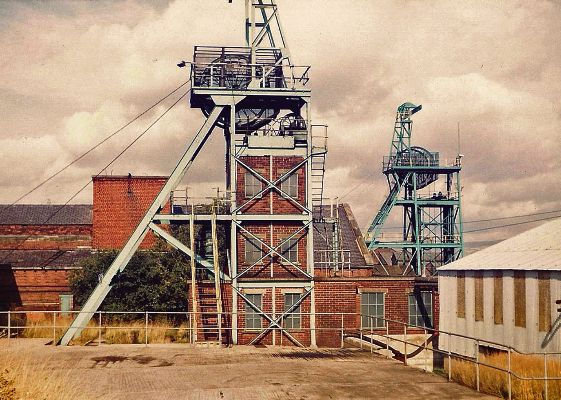
Hapton Valley Colliery
Used with kind permission of b3tarev3
There were two collieries at Hapton Valley and they worked an area of coal confined to a synclinal trough, between the Habergham and Hapton Faults. The trough ran from the outcrop of the seams near Higham village in the north-west to the Thieveley Fault in the south-east. It was split down the centre by the Deerplay Fault. Before 1954 all the workings were confined to the area to the north-west of the latter fault.
Sinking began at the first colliery, known locally as Spa Pit, in 1853. It was owned by the Exors of John Hargreaves Ltd and its two shafts reached the Lower Mountain at a depth of 128 metres. Unfortunately, they encountered the Aitken line, where the Union Mine splits into the Lower Mountain and Upper Foot Mines, which is associated with difficult geological conditions. The seam was also very wet, so the shafts were then backfilled to the Upper Mountain horizon. In the late 1880s Spa Pit’s shafts were increased in diameter and a large pumping was installed. A note against the entry for Hapton Valley in the List of Mines for 1890 says “Re-commenced”.
By 1908 Messrs Hargreaves began sinking two new shafts (Nos 3 & 4) some 200 metres north-west of Spa Pit. They had reached the Lower Mountain Mine, at a depth of 157 metres, by 1910. By 1915 the new pit was becoming well established and manpower was being moved to it from the Old Pit. Nevertheless, the two pits were worked together until the early 1930s, when Spa Pit closed.
When the NCB took over it began investing in collieries seen to have a future and closing or merging those which did not. Hapton Valley was one of the former and contractors soon began driving new drifts to develop the coal on the downthrow side of the Deerplay Fault. In 1951 new tub circuits, using larger tubs were built both at the surface and in the pit bottom. The East Side Drifts were completed in 1954, and the haulage of tubs on endless ropes ended in 1958 when conveyor belts were installed.
A new surface drift, begun in 1961, was driven to intersect the Upper Mountain and Union Mines. In future coal would be brought from mechanised faces, in both seams, to the surface on conveyor belts.
On the 22nd March 1962, a methane explosion on the No 2 face on the Union Seam initially claimed the lives of 16 men. A further 21 miners, 3 of whom later died, were admitted to hospital with serious injuries. The full report can be found here.
Hapton Valley survived the closure of Bank Hall, to become Burnley’s last deep mine. It kept working for another eleven years until the risk of working near flooded workings was considered too great and so was closed on April 26th 1982.
Further reading:
- Seal, C.S. 1995 “The Darker Side of a Golden Era” British Mining No.55, NMRS, pp.112-126
- Nadin, J. 1997 The Coal Mines of East-Lancashire (British Mining No.58, NMRS)
- Williamson, I.A. 1999 “The Burnley Coalfield” British Mining No.63, NMRS, pp.5-27

